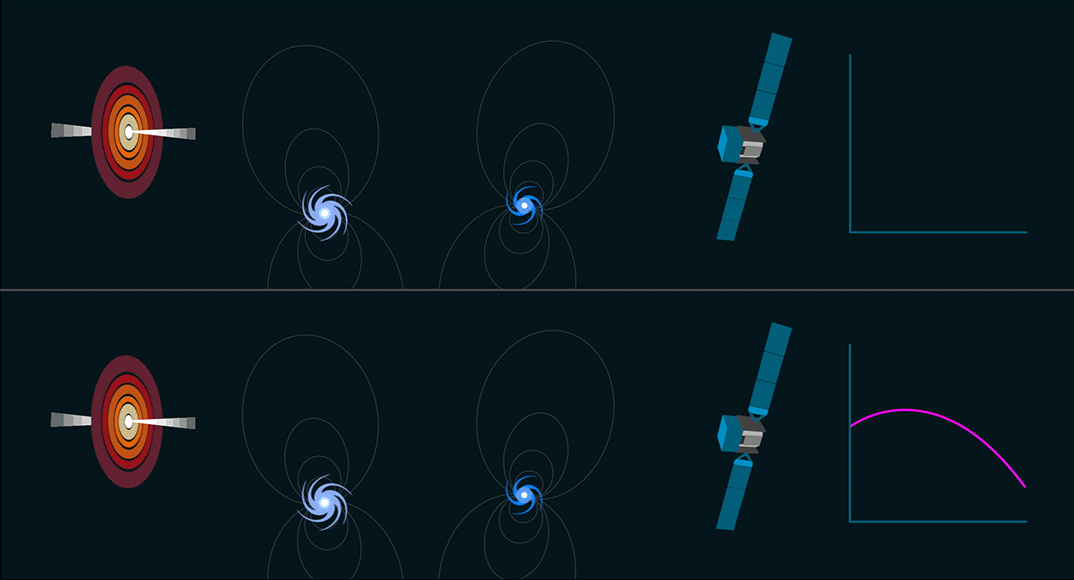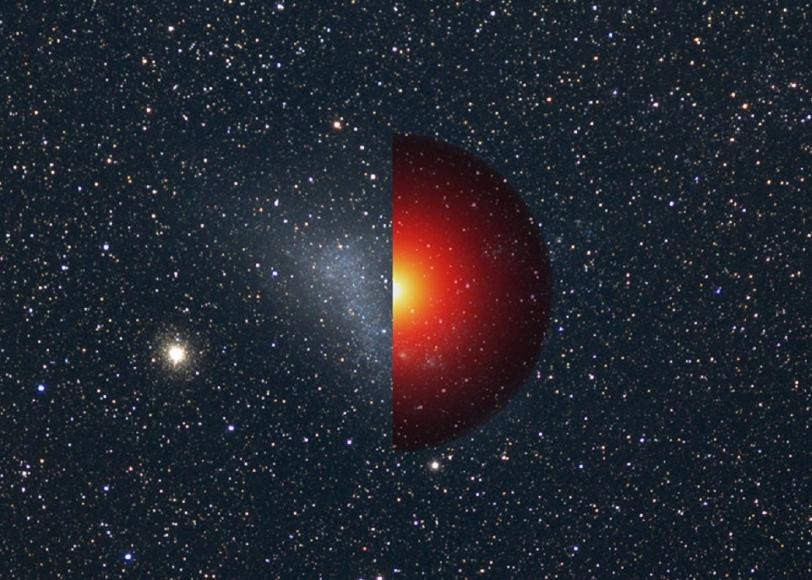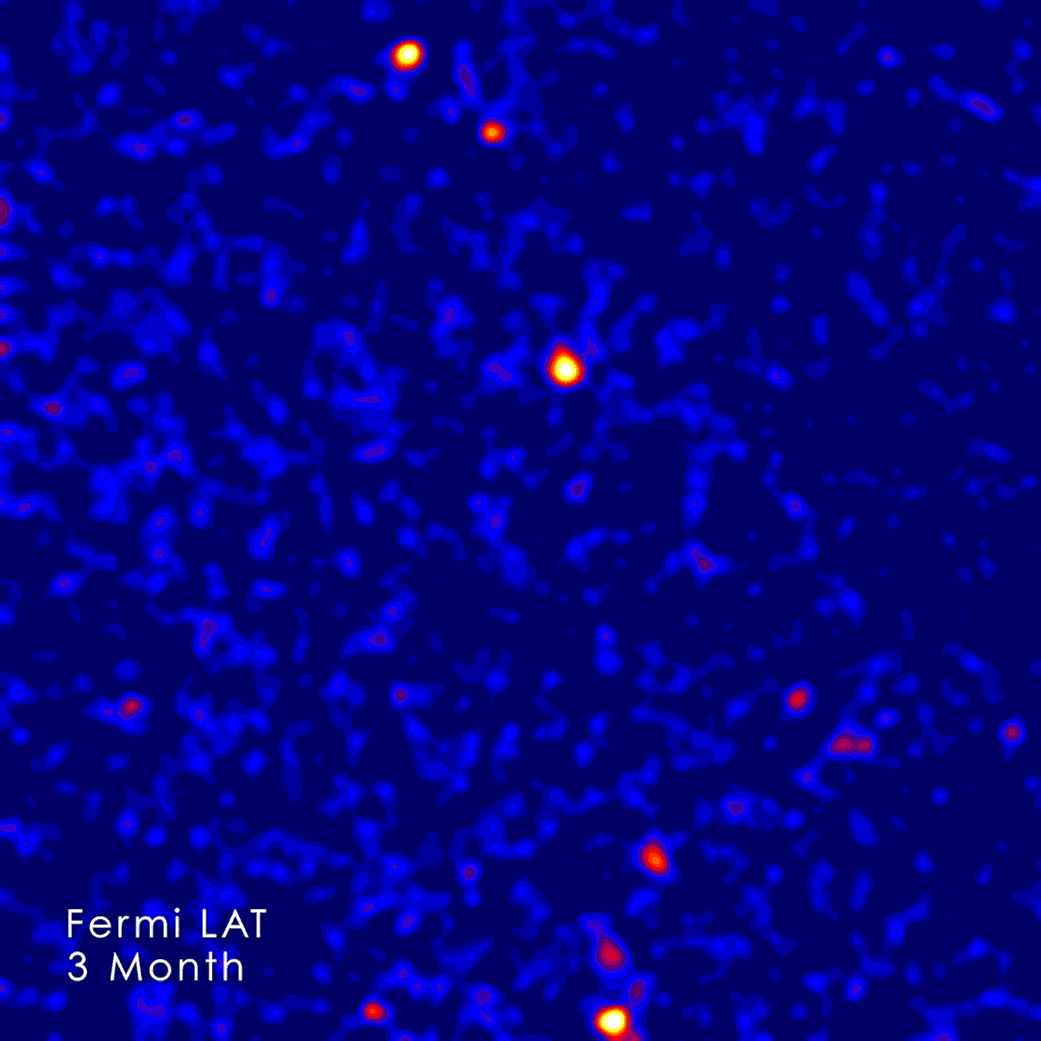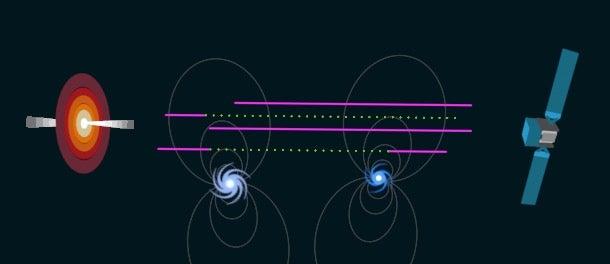Fermi Researchers Explore New Ways of Searching for Dark Matter
Three Studies Expand the Hunt for Unexplained Cosmic Gamma-ray Signals
Researchers working with more than six years of data from NASA's Fermi Gamma-ray Space Telescope have used novel approaches to search for cosmic signals that could reveal what mysterious dark matter is made of. The scientists looked for hypothetical axion particles, studied the gamma-ray emissions from a large satellite galaxy of our Milky Way and analyzed the faint glow of gamma rays that covers the entire sky.
Although none of these studies identified signals clearly attributable to dark matter, the results help scientists determine what dark matter cannot be by ruling out numerous theoretical dark matter models.
“The new approaches have set tight limits on the properties of dark matter, complementing and extending previous results,” says Seth Digel, who leads the Fermi team at the Kavli Institute for Particle Astrophysics and Cosmology (KIPAC), a joint institute of Stanford University and the Department of Energy’s SLAC National Accelerator Laboratory.

The nature of invisible dark matter remains one of the biggest mysteries of modern science. Because dark matter makes up 85 percent of all matter in the universe, it affects how galaxies rotate and how light passes through massive galaxy clusters. But what exactly is dark matter, and what are its constituents?
Astrophysicists do not know the answers, but they believe that dark matter might be composed of hypothetical particles. Gamma rays as detected by the Fermi telescope can potentially help reveal their existence. Previously, Fermi has searched for telltale gamma-ray signals associated with dark matter in the center of our galaxy and in small dwarf galaxies orbiting our own. The new studies take this search to the next level.
Gamma Rays Turning into Axions and Vice Versa
The first study investigated the possibility that dark matter consists of hypothetical particles called axions or other contenders with similar properties. An intriguing aspect of axion-like particles is their ability to convert into gamma rays and back again when they interact with strong magnetic fields. These conversions would leave behind characteristic traces, like gaps or steps, in the spectrum of a bright gamma-ray source.
A team led by Manuel Meyer at Stockholm University searched for these effects in the gamma rays from the central galaxy of the Perseus galaxy cluster, whose high-energy emissions are thought to be associated with a supermassive black hole at its center. Like all galaxy clusters, the Perseus cluster is filled with hot gas threaded with magnetic fields, potentially enabling the switch from gamma rays to axion-like particles and vice versa.

Meyer's team collected observations from Fermi's Large Area Telescope (LAT) but didn’t find any axion-related distortions in the gamma-ray signal. The findings, published April 20 in Physical Review Letters, exclude a small range of axion-like particles that could have comprised about 4 percent of dark matter.
"While we don't yet know what dark matter is, our results show we can probe axion-like models and provide the strongest constraints to date for certain masses," Meyer says. "Remarkably, we reached a sensitivity we thought would only be possible in a dedicated laboratory experiment, which is quite a testament to Fermi."
WIMPs Decaying or Annihilating Each Other in Space
Other dark matter candidates are so-called weakly interacting massive particles (WIMPs). In some theoretical models, colliding WIMPs either annihilate each other or decay in space; both scenarios should result in gamma rays that could be detected by the LAT.
In the second study, scientists sought these signals from the Small Magellanic Cloud (SMC), the second-largest of the satellite galaxies orbiting our Milky Way. The SMC’s conventional sources of gamma rays, such as pulsars and processes related to the formation of massive stars, are well established, and its dark matter content is known from the galaxy’s well-measured rotation.
“These properties make the SMC a great object for searches for any unexplained gamma-ray excess, which could potentially be a WIMP signature,” says KIPAC researcher Eric Charles, co-author of a paper published on March 22 in Physical Review D.

The researchers modeled the dark matter content of the satellite galaxy, showing it possesses enough dark matter to theoretically produce detectable signals for two WIMP types.
However, "no signal from dark matter annihilation was found to be statistically significant," says lead author Regina Caputo from the University of California, Santa Cruz. "The LAT definitely sees gamma rays from the SMC, but we can explain them all through conventional sources."
An Extragalactic Glow of Gamma Rays
In the third study, a research team led by Clemson University’s Marco Ajello and KIPAC’s Mattia Di Mauro took the search in a different direction. Instead of looking at specific astronomical targets, the team analyzed the background glow of gamma rays seen all over the sky.
The nature of this light, called the extragalactic gamma-ray background (EGB), has been debated since it was first measured by NASA's Small Astronomy Satellite 2 in the early 1970s. Fermi has shown that much of this light arises from gamma-ray sources that cannot be identified as individual sources, particularly galaxies called blazars that are powered by material falling toward gigantic black holes.
Some models predict that EGB gamma rays could also arise from distant interactions of dark matter particles, such as the annihilation or decay of WIMPs.
“We performed a statistical analysis of the EGB, in which we looked at very dim objects and asked whether we can account for all detected gamma-ray photons with known astrophysical sources,” says Di Mauro.

The detailed analysis, published April 14 in Physical Review Letters, shows that the researchers can in fact explain nearly all of this emission.
"There is very little room left for signals from exotic sources in the EGB, which in turn means that any contribution from these sources must be quite small," Ajello says. "This information may help us place limits on how often WIMP particles collide or decay."
NASA's Fermi Gamma-ray Space Telescope is an astrophysics and particle physics partnership, developed in collaboration with the U.S. Department of Energy and with important contributions from academic institutions and partners in France, Germany, Italy, Japan, Sweden and the United States. A number of researchers from SLAC are members of the international Fermi-LAT collaboration. SLAC assembled the LAT and hosts the operations center that processes LAT data.
Editor’s note: This text is based on a NASA feature.
Citations: M. Ajello et al., Physical Review Letters, 20 April 2016 (10.1103/PhysRevLett.116.161101); R. Caputo et al., Physical Review D, 22 March 2016 (10.1103/PhysRevD.93.062004); M. Ackermann et al., Physical Review Letters, 14 April 2016 (10.1103/PhysRevLett.116.151105).
For questions or comments, contact the SLAC Office of Communications at communications@slac.stanford.edu.
SLAC is a multi-program laboratory exploring frontier questions in photon science, astrophysics, particle physics and accelerator research. Located in Menlo Park, Calif., SLAC is operated by Stanford University for the U.S. Department of Energy's Office of Science.
SLAC National Accelerator Laboratory is supported by the Office of Science of the U.S. Department of Energy. The Office of Science is the single largest supporter of basic research in the physical sciences in the United States, and is working to address some of the most pressing challenges of our time. For more information, please visit science.energy.gov.






